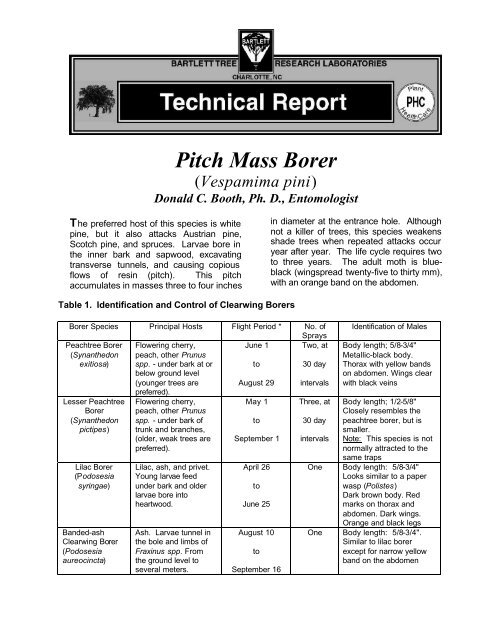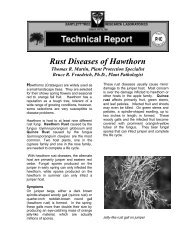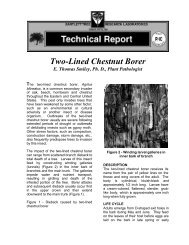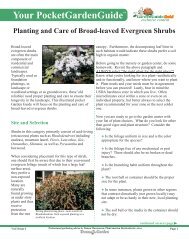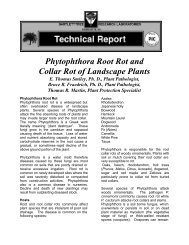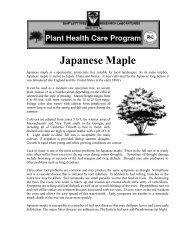Pitch Mass Borer - Online Gardener
Pitch Mass Borer - Online Gardener
Pitch Mass Borer - Online Gardener
Create successful ePaper yourself
Turn your PDF publications into a flip-book with our unique Google optimized e-Paper software.
<strong>Pitch</strong> <strong>Mass</strong> <strong>Borer</strong><br />
(Vespamima pini)<br />
Donald C. Booth, Ph. D., Entomologist<br />
The preferred host of this species is white<br />
pine, but it also attacks Austrian pine,<br />
Scotch pine, and spruces. Larvae bore in<br />
the inner bark and sapwood, excavating<br />
transverse tunnels, and causing copious<br />
flows of resin (pitch). This pitch<br />
accumulates in masses three to four inches<br />
in diameter at the entrance hole. Although<br />
not a killer of trees, this species weakens<br />
shade trees when repeated attacks occur<br />
year after year. The life cycle requires two<br />
to three years. The adult moth is blueblack<br />
(wingspread twenty-five to thirty mm),<br />
with an orange band on the abdomen.<br />
Table 1. Identification and Control of Clearwing <strong>Borer</strong>s<br />
<strong>Borer</strong> Species Principal Hosts Flight Period * No. of<br />
Sprays<br />
Peachtree <strong>Borer</strong> Flowering cherry,<br />
June 1 Two, at<br />
(Synanthedon peach, other Prunus<br />
exitiosa) spp. - under bark at or to 30 day<br />
below ground level<br />
(younger trees are August 29 intervals<br />
Lesser Peachtree<br />
<strong>Borer</strong><br />
(Synanthedon<br />
pictipes)<br />
Lilac <strong>Borer</strong><br />
(Podosesia<br />
syringae)<br />
Banded-ash<br />
Clearwing <strong>Borer</strong><br />
(Podosesia<br />
aureocincta)<br />
preferred).<br />
Flowering cherry,<br />
peach, other Prunus<br />
spp. - under bark of<br />
trunk and branches,<br />
(older, weak trees are<br />
preferred).<br />
Lilac, ash, and privet.<br />
Young larvae feed<br />
under bark and older<br />
larvae bore into<br />
heartwood.<br />
Ash. Larvae tunnel in<br />
the bole and limbs of<br />
Fraxinus spp. From<br />
the ground level to<br />
several meters.<br />
May 1<br />
to<br />
September 1<br />
April 26<br />
to<br />
June 25<br />
August 10<br />
to<br />
September 16<br />
Identification of Males<br />
Body length; 5/8-3/4"<br />
Metallic-black body.<br />
Thorax with yellow bands<br />
on abdomen. Wings clear<br />
with black veins<br />
Three, at Body length; 1/2-5/8"<br />
Closely resembles the<br />
30 day peachtree borer, but is<br />
smaller.<br />
intervals Note: This species is not<br />
normally attracted to the<br />
same traps<br />
One Body length: 5/8-3/4"<br />
Looks similar to a paper<br />
wasp (Polistes)<br />
Dark brown body. Red<br />
marks on thorax and<br />
abdomen. Dark wings.<br />
Orange and black legs<br />
One Body length: 5/8-3/4".<br />
Similar to lilac borer<br />
except for narrow yellow<br />
band on the abdomen
2<br />
<strong>Borer</strong> Species Principal Hosts Flight Period * No. of<br />
Sprays<br />
Oak <strong>Borer</strong><br />
May 18<br />
(Paranthrene<br />
simulans)<br />
to<br />
Rhododendron<br />
<strong>Borer</strong><br />
(Synanthedon<br />
rhododendri)<br />
Dogwood <strong>Borer</strong><br />
(Synanthedon<br />
scitula)<br />
Most oaks,<br />
particularly mature<br />
red oak and young<br />
pin oak<br />
Rhododendron in<br />
full sun are<br />
preferred;<br />
occasionally found<br />
in mountain-laurel<br />
and deciduous<br />
azaleas<br />
Dogwood, pecan,<br />
apple, hickory,<br />
cherry, and others<br />
June 11<br />
May 30<br />
to<br />
July 4<br />
May 21<br />
to<br />
June 30<br />
(emergence<br />
from dogwood)<br />
* Flight period is based on trapping in Lexington, Kentucky<br />
Identification of Males<br />
One Body length: 5/8-7/8"<br />
Looks identical to a<br />
yellowjacket wasp<br />
(Vespa spp.). Black<br />
and yellow body. Wings<br />
clear with areas of<br />
brown. Antennae black<br />
with brown tips<br />
One Body length: 3/8-1/2"<br />
Black body. Three<br />
yellow bands on<br />
abdomen. Legs yellow<br />
and black<br />
One Body length: 3/8-1/2"<br />
Black body. Two yellow<br />
bands on abdomen.<br />
Legs yellow and black<br />
BTRL 12/99<br />
TR-65


